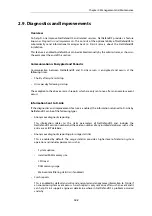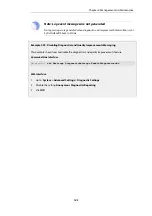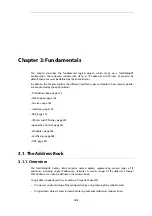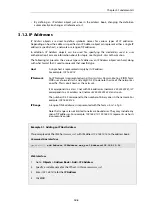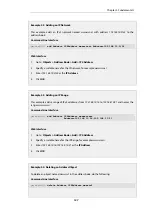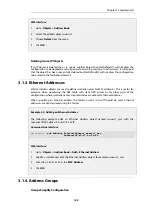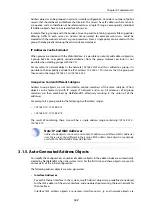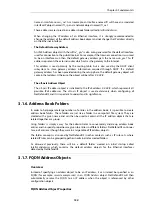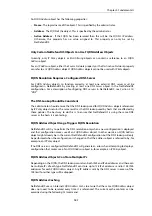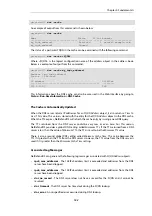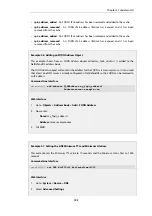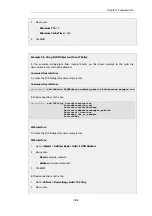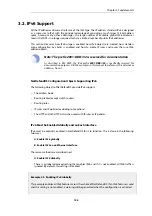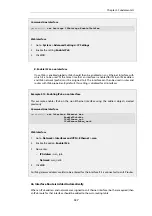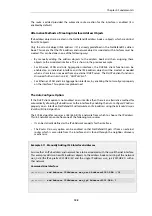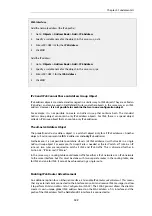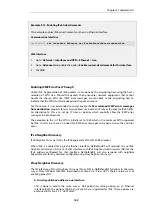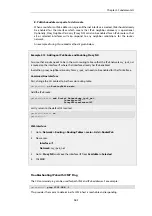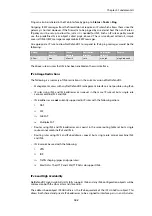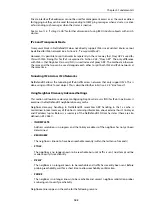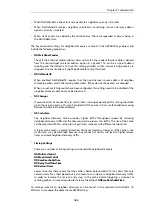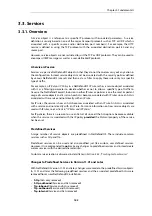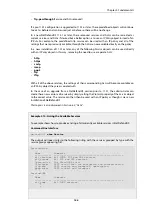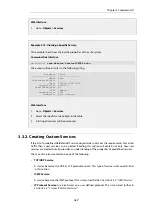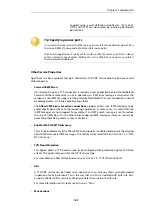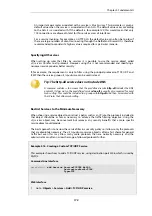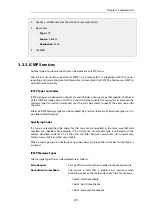
3.2. IPv6 Support
All the IP addresses discussed so far are of the
IPv4
type. The IP address standard
IPv6
is designed
as a successor to IPv4 with the principal advantage of providing a much larger 128 bit address
space. Among many other advantages, the large number of available global IPv6 addresses
means that NAT is no longer required to share a limited number of public IPv4 addresses.
This section discusses how IPv6 usage is enabled, how IPv6 objects are created, how stateless
auto-configuration by clients is enabled and how to create IP rules and routes that use IPv6
address objects.
Note: The prefix 2001:DB8::/32 is reserved for documentation
As described in RFC 3849, the IPv6 prefix
2001:DB8::/32
is specifically reserved for
documentation purposes. All IPv6 examples in this manual therefore use this network or
addresses from it.
NetDefendOS Configuration Objects Supporting IPv6
The following objects of NetDefendOS provide IPv6 support:
•
The address book.
•
Routing tables (except switch routes).
•
Routing rules.
•
IP rules and IP policies (excluding some actions).
•
The HTTP and LW-HTTP ALGs when used with IP rules or IP policies.
IPv6 Must be Enabled Globally and on Each Interface
IPv6 must be explicitly enabled in NetDefendOS for it to function. This is done in the following
two ways:
A. Enable IPv6 globally.
B. Enable IPv6 on an Ethernet interface.
These two methods are described next.
A. Enable IPv6 Globally
There is a global advanced setting that enables IPv6 and if it is not enabled, all IPv6 traffic is
ignored. By default, this setting is disabled.
Example 3.9. Enabling IPv6 Globally
This example enables all IPv6 features across the whole of NetDefendOS. If an IPv6 feature is used
and this setting is not enabled, a warning will be generated when the configuration is activated.
Chapter 3: Fundamentals
156
Содержание NetDefendOS
Страница 30: ...Figure 1 3 Packet Flow Schematic Part III Chapter 1 NetDefendOS Overview 30 ...
Страница 32: ...Chapter 1 NetDefendOS Overview 32 ...
Страница 144: ...Chapter 2 Management and Maintenance 144 ...
Страница 220: ... Enable DHCP passthrough Enable L2 passthrough for non IP protocols 4 Click OK Chapter 3 Fundamentals 220 ...
Страница 267: ... SourceNetwork lannet DestinationInterface any DestinationNetwork all nets 4 Click OK Chapter 3 Fundamentals 267 ...
Страница 284: ...Chapter 3 Fundamentals 284 ...
Страница 360: ...The ospf command options are fully described in the separate NetDefendOS CLI Reference Guide Chapter 4 Routing 360 ...
Страница 392: ...Chapter 4 Routing 392 ...
Страница 396: ...Web Interface 1 Go to Network Ethernet If1 2 Select Enable DHCP 3 Click OK Chapter 5 DHCP Services 396 ...
Страница 419: ... Host 2001 DB8 1 MAC 00 90 12 13 14 15 5 Click OK Chapter 5 DHCP Services 419 ...
Страница 420: ...Chapter 5 DHCP Services 420 ...
Страница 424: ...2 Now enter Name lan_Access Action Expect Interface lan Network lannet 3 Click OK Chapter 6 Security Mechanisms 424 ...
Страница 573: ...Chapter 6 Security Mechanisms 573 ...
Страница 575: ...This section describes and provides examples of configuring NAT and SAT rules Chapter 7 Address Translation 575 ...
Страница 607: ...Chapter 7 Address Translation 607 ...
Страница 666: ...Chapter 8 User Authentication 666 ...
Страница 775: ...Chapter 9 VPN 775 ...
Страница 819: ...Chapter 10 Traffic Management 819 ...
Страница 842: ...Chapter 11 High Availability 842 ...
Страница 866: ...Default Enabled Chapter 13 Advanced Settings 866 ...
Страница 879: ...Chapter 13 Advanced Settings 879 ...

